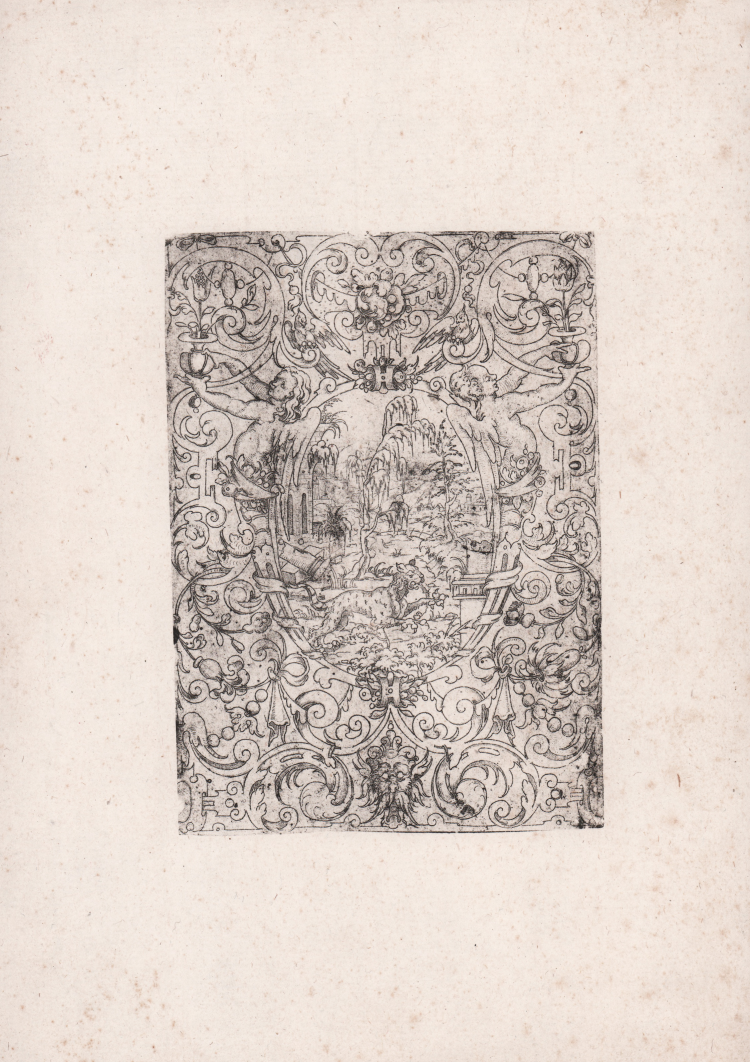



| Reference: | S42134 |
| Author | Matthias Zundt |
| Year: | 1551 ca. |
| Measures: | 110 x 151 mm |


| Reference: | S42134 |
| Author | Matthias Zundt |
| Year: | 1551 ca. |
| Measures: | 110 x 151 mm |
Etching, circa 1551, without printing details.
Counterproof, printed on laid paper, with wide margins, in perfect condition.
Matthias Zündt was an engraver, sculptor and goldsmith. His work was influenced by the ‘Little Masters’, a group of sixteenth-century printmakers, predominantly from Nuremberg, who specialized in producing very small prints. Zündt is famous for incorporating sea horses and satyrs in his work. Trained in Nuremberg by court goldsmith, Wenzel Jamnitzer, he made many etchings that served as templates for gold and silversmiths. These appear in his specimen book Insigne Ac Planè Novum Opus Cratero graphicum (1551). Later in his career, between 1565 and 1571, Zundt tried other areas, including maps.
On the title page to the series of Insigne Ac Planè Novum Opus Cratero graphicum cups, candlesticks, vases, and other types of vessels he published in 1551, he states that his illustrations were intended to inspire goldsmiths, sculptors, painters, and other artists in works of their own. We can assume, however, that Zündt’s effort was not entirely altruistic. By publishing these and many other designs, he ensured an increase in his own fame and drew attention to his own capabilities as a goldsmith in the hopes of attracting more commissions.
Bibliografia
Andresen, A., Der deutsche Peintre-Graveur…von dem letzten Drittel des 16. Jahrhunderts bis zum Schluss des 18. Jahrhunderts, Leipzig, 1864-1878, Vol. I, pp. 30-1.
Matthias Zundt (Norimberga circa 1498 - 1572)
|
Matthias Zündt was an engraver, sculptor and goldsmith. His work was influenced by the ‘Little Masters’, a group of sixteenth-century printmakers, predominantly from Nuremberg, who specialized in producing very small prints. Zündt is famous for incorporating sea horses and satyrs in his work. Trained in Nuremberg by court goldsmith, Wenzel Jamnitzer, he made many etchings that served as templates for gold and silversmiths. These appear in his specimen book Insigne Ac Planè Novum Opus Cratero graphicum (1551). Later in his career, between 1565 and 1571, Zundt tried other areas, including maps.
|
Matthias Zundt (Norimberga circa 1498 - 1572)
|
Matthias Zündt was an engraver, sculptor and goldsmith. His work was influenced by the ‘Little Masters’, a group of sixteenth-century printmakers, predominantly from Nuremberg, who specialized in producing very small prints. Zündt is famous for incorporating sea horses and satyrs in his work. Trained in Nuremberg by court goldsmith, Wenzel Jamnitzer, he made many etchings that served as templates for gold and silversmiths. These appear in his specimen book Insigne Ac Planè Novum Opus Cratero graphicum (1551). Later in his career, between 1565 and 1571, Zundt tried other areas, including maps.
|